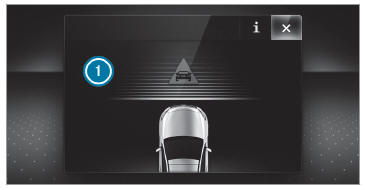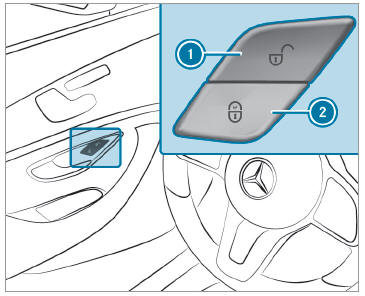Mercedes-Benz GLC : Driving and driving safety systems / Active Brake Assist
Function of Active Brake Assist
Active Brake Assist consists of the following functions:
- Distance warning function
- Autonomous braking function
- Situation-dependent braking assistance
- Vehicles with Driving Assistance Package: Evasive Steering Assist and cornering function
Active Brake Assist can help you to minimize the risk of a collision with vehicles, cyclists or pedestrians or to reduce the effects of such a collision.
If Active Brake Assist has detected a risk of collision,
a warning tone sounds and the  distance
warning lamp lights up in the instrument
cluster.
distance
warning lamp lights up in the instrument
cluster.
If you do not react to the warning, autonomous braking can be initiated in critical situations.
In especially critical situations, Active Brake Assist can initiate autonomous braking directly.
In this case, the warning lamp and warning tone occur simultaneously with the braking application.
If you apply the brake yourself in a critical situation or apply the brake during autonomous braking, situation-dependent braking assistance occurs. The brake pressure increases up to maximum full-stop braking if necessary.
Observe the notes on driving systems and your responsibility; you may otherwise fail to recognize dangers.

If autonomous braking or situation-dependent
braking assistance has occurred, display
 appears in the multifunction
display and then
automatically goes out after a short time.
appears in the multifunction
display and then
automatically goes out after a short time.
WARNING Risk of an accident caused by limited detection performance of Active Brake Assist
Active Brake Assist cannot always clearly identify objects and complex traffic situations.
Active Brake Assist is only an aid. The driver is responsible for maintaining a sufficiently safe distance to the vehicle in front, vehicle speed and for braking in good time.
 Always pay careful
attention to the traffic
situation; do not rely on Active Brake
Assist alone.
Always pay careful
attention to the traffic
situation; do not rely on Active Brake
Assist alone.
 Be prepared to brake or
swerve if necessary.
Be prepared to brake or
swerve if necessary.
Also observe the system limits of Active Brake Assist.
The individual subfunctions are available in various speed ranges:
The distance warning function can issue a warning in the following situations:
From approximately 4 mph (7 km/h), if your
vehicle is critically close to a vehicle, cyclist
or pedestrian, you will hear an intermittent
warning tone and the  distance
warning
lamp lights up in the instrument cluster.
distance
warning
lamp lights up in the instrument cluster.
Brake immediately or take evasive action, provided it is safe to do so and the traffic situation allows this.
Distance warning function (vehicles without Driving Assistance Package)
The distance warning function can aid you in the following situations with an intermittent warning tone and a warning lamp:
- at speeds up to approximately 155 mph (250 km/h) when approaching vehicles ahead
- at speeds up to approximately 50 mph (80 km/h) when approaching stationary vehicles, moving pedestrians and cyclists ahead
- at speeds up to approximately 37 mph (60 km/h) when approaching crossing cyclists
Distance warning function (vehicles with Driving Assistance Package)
The distance warning function can aid you in the following situations with an intermittent warning tone and a warning lamp:
- at speeds up to approximately 155 mph (250 km/h) when approaching vehicles ahead
- at speeds up to approximately 62 mph (100 km/h) when approaching stationary vehicles
- at speeds up to approximately 50 mph (80 km/h) when approaching moving pedestrians and cyclists ahead
- at speeds up to approximately 43 mph (70 km/h) when approaching stationary pedestrians, crossing vehicles and stationary and crossing cyclists
Autonomous braking function (vehicles without Driving Assistance Package)
If the vehicle is traveling at speeds above approximately 4 mph (7 km/h), the autonomous braking function may intervene in the following situations:
- at speeds up to approximately 124 mph (200 km/h) when approaching vehicles ahead
- at speeds up to approximately 50 mph (80 km/h) when approaching cyclists ahead
- at speeds up to approximately 37 mph (60 km/h) when approaching moving pedestrians and crossing cyclists
- at speeds up to approximately 31 mph (50 km/h) when approaching stationary vehicles
Autonomous braking function (vehicles with Driving Assistance Package)
If the vehicle is traveling at speeds above approximately 4 mph (7 km/h), the autonomous braking function may intervene in the following situations:
- at speeds up to approximately 155 mph (250 km/h) when approaching vehicles ahead
- at speeds up to approximately 62 mph (100 km/h) when approaching stationary vehicles
- at speeds up to approximately 50 mph (80 km/h) when approaching cyclists ahead
- at speeds up to approximately 43 mph (70 km/h) when approaching stationary and moving pedestrians, crossing vehicles and stationary and crossing cyclists
Situation-dependent braking assistance (vehicles without Driving Assistance Package)
- The situation-dependent braking assistance can intervene from a speed of approximately 4 mph (7 km/h) in the following situations:
- at speeds up to approximately 155 mph (250 km/h) when approaching vehicles ahead
- at speeds up to approximately 50 mph (80 km/h) when approaching stationary vehicles and vehicles ahead
- at speeds up to approximately 37 mph (60 km/h) when approaching moving pedestrians and crossing cyclists
Situation-dependent braking assistance (vehicles with Driving Assistance Package)
The situation-dependent braking assistance can intervene from a speed of approximately 4 mph (7 km/h) in the following situations:
- at speeds up to approximately 155 mph (250 km/h) when approaching vehicles ahead
- at speeds up to approximately 62 mph (100 km/h) when approaching stationary vehicles
- at speeds up to approximately 50 mph (80 km/h) when approaching cyclists ahead
- at speeds up to approximately 37 mph (60 km/h) when approaching stationary and moving pedestrians, crossing vehicles and stationary and crossing cyclists
Canceling a brake application of Active Brake Assist
You can cancel a brake application of Active Brake Assist at any time by:
- sharply depressing the accelerator pedal or with kickdown
- releasing the brake pedal
Active Brake Assist may cancel the brake application when one of the following conditions is fulfilled:
- You maneuver to avoid the obstacle.
- There is no longer a risk of collision.
- An obstacle is no longer detected in front of your vehicle.
Evasive Steering Assist (only vehicles with Driving Assistance Package)
Evasive Steering Assist has the following characteristics:
- The ability to detect stationary or moving pedestrians.
- Assistance through power-assisted steering if it detects a swerving maneuver.
- Activation by an abrupt steering movement during a swerving maneuver.
- Assistance during swerving and straightening of the vehicle.
- Reaction from a speed of approximately 12 mph (20 km/h) up to a speed of approximately 43 mph (70 km/h).
You can prevent the assistance at any time by actively steering.
Cornering function (only vehicles with Driving Assistance Package)
If a danger of collision from an oncoming vehicle is detected when turning across an oncoming lane, autonomous braking can be initiated at speeds below 9 mph (15 km/h) before you have left the lane in which you are driving.
WARNING Risk of accident despite Evasive Steering Assist
Evasive Steering Assist cannot always recognize objects or complex traffic situations clearly.
Moreover, the steering support provided by Evasive Steering Assist is not sufficient to avoid a collision.
 Always pay careful
attention to the traffic
situation; do not rely on Evasive
Steering Assist alone.
Always pay careful
attention to the traffic
situation; do not rely on Evasive
Steering Assist alone.
 Be prepared to brake or
swerve if necessary.
Be prepared to brake or
swerve if necessary.
 End the support by
actively steering in
non-critical situations.
End the support by
actively steering in
non-critical situations.
 Drive at an appropriate
speed if there
are pedestrians close to the path of
your vehicle.
Drive at an appropriate
speed if there
are pedestrians close to the path of
your vehicle.
System limits
Full system performance is not available for a few seconds after switching on the ignition or after driving off.
If Active Brake Assist is impaired or inoperative
due to a malfunction, the  warning
lamp
appears in the multifunction display.
warning
lamp
appears in the multifunction display.
The system may be impaired or may not function, particularly in the following situations:
- In snow, rain, fog, heavy spray, if there is glare, in direct sunlight or in greatly varying ambient light.
- If the sensors are dirty, fogged up, damaged or covered.
- If the sensors are impaired due to interference from other radar sources, e.g. strong radar reflections in parking garages.
- If a loss of tire pressure or a faulty tire has been detected and displayed.
- If DSR is active.
- In complex traffic situations where objects cannot always be clearly identified.
- If pedestrians or vehicles move quickly into the sensor detection range.
- If pedestrians are hidden by other objects.
- If the typical outline of a pedestrian cannot be distinguished from the background.
- If a pedestrian is not detected as such, e.g. due to special clothing or other objects.
- If the driver's seat belt is not fastened.
- On curves with a tight radius.
The Active Brake Assist sensors adjust automatically while a certain distance is being driven after the vehicle has been delivered. Active Brake Assist is unavailable or only partially available during the teach-in process.
 Active Lane Change Assist
Active Lane Change Assist
Function of Active Lane Change Assist
Active Lane Change Assist supports the driver
when changing lanes by applying steering torque
if the driver operates a turn signal indicator...
 Activating/deactivating Active Brake Assist
Activating/deactivating Active Brake Assist
Requirements:
The ignition is switched on.
Multimedia system:
Settings
Assistance
Active Brake Assist
Select the desired setting.
The setting is retained when the drive system
is next started...
Other information:
Mercedes-Benz GLC 2016-2025 Owners Manual: Specifying the starting point for the warning tones
Y..
Mercedes-Benz GLC 2016-2025 Owners Manual: Adjusting the Head-up Display settings on the on-board computer
On-board computer: Head-up Disp. Setting currently selected Digital speedometer Traffic Sign Assist Navigation displays The following can be adjusted for the Head-up Display: Position Brightness Display Content To select a setting: swipe upwards or downwards on the left-hand Touch Control...

